One-Pot Hydrothermal Synthesis of Victoria Green (Ca3Cr2Si3O12) Nanoparticles in Alkaline Fluids and Its Colour Hue Characterisation
Abstract
1. Introduction
2. Materials and Methods
2.1. Materials and Ca:Cr:Si Precursor Preparation
2.2. Hydrothermal Treatments
2.2.1. Treatments Conducted under Stirring Conditions
2.2.2. Treatments Conducted under Non-Stirring Conditions
2.3. Characterisation
3. Results and Discussion
3.1. The Effect of the Alkalinity on the Ca3Cr2Si3O12 Chemical Stability under Hydrothermal Synthesis
Ca3Cr2Si3O12(s) + 5NO3−(aq) + 2Na+(aq) + (24 − y)OH−(aq)
3.2. Structural Features of the Victorian Green Ca3Cr2Si3O12 Powders Prepared under Alkaline Hydrothermal Conditions
3.3. Tailoring the Synthesis of the Ca3Cr2Si3O12 by Controlling the Nominal Si4+ Content
3.4. Morphology Evolution of Ca3Cr2Si3O12 Particles Prepared under Alkaline Hydrothermal Conditions
3.5. Diffuse Reflectance and Chromatic Properties of Ca3Cr2Si3O12 Victorian Green Powders
4. Conclusions
Supplementary Materials
Author Contributions
Funding
Acknowledgments
Conflicts of Interest
References
- Parthasarathy, G.; Balaram, V.; Srinivasan, R. Characterization of green garnets from an archean calc-silicate rock, Bandihalli, Karnataka, India: Evidence for a continuous solid solution between Uvarovite and Grandite. J. Asian. Earth. Sci. 1999, 17, 345–352. [Google Scholar] [CrossRef]
- Valenzano, L.; Pascale, F.; Ferrero, M.; Dovesi, R. Ab Initio quantum-mechanical prediction of the IR and Raman spectra of Ca3Cr2Si3O12 Uvarovite Garnet. Int. J. Quantum Chem. 2010, 110, 416–421. [Google Scholar] [CrossRef]
- Izawa, M.R.M.; Cloutis, E.A.; Rhind, T.; Mertzman, S.A.; Poitras, J.; Applin, D.M.; Mann, P. Spectral reflectance (0.35–2.5 μm) properties of garnets: Implications for remote sensing detection and characterisation. Icarus 2018, 300, 392–410. [Google Scholar] [CrossRef]
- Andrut, M.; Wildner, M.; Beran, A. The crystal chemistry of birefringent natural Uvarovites. Part IV. OH defect incorporation mechanisms in non-cubic garnets derived from polarised IR spectroscopy. Eur. J. Mineral. 2002, 14, 1019–1026. [Google Scholar] [CrossRef]
- Gréaux, S.; Yamada, A. Density variations of Cr-rich garnets in the upper mantle inferred from the elasticity of Uvarovite garnet. C. R. Geosci. 2019, 351, 95–103. [Google Scholar] [CrossRef]
- Novak, G.A.; Gibbs, G.V. The crystal chemistry of the silicate garnet. Am. Mineral. 1971, 56, 791–825. [Google Scholar]
- Carda, J.; Monros, G.; Esteve, V.; Amigo, J.M. Cation distribution by powder X-ray diffraction in Uvarovite-Grossularite garnets solid solutions synthesised by the sol-gel method. J. Solid. State. Chem. 1994, 108, 24–28. [Google Scholar] [CrossRef]
- Antao, S.M.; Salvador, J.J. Crystal chemistry of birefringent Uvarovite solid solutions. Minerals 2019, 9, 395. [Google Scholar] [CrossRef]
- Verger, L.; Dargaud, O.; Chassé, M.; Trcera, N.; Rousse, G.; Cormier, L. Synthesis, properties and uses of chromium-based pigments from the manufacture de sèvres. J. Cult. Herit. 2018, 30, 26–33. [Google Scholar] [CrossRef]
- Hummel, F.A. Synthesis of Uvarovite. Am. Miner. 1950, 35, 324–325. [Google Scholar]
- Isaacs, T. Synthesis of Uvarovite. Nature 1963, 4887, 1291. [Google Scholar] [CrossRef]
- De Villiers, J.P.R.; Muan, A. Liquidus-solidus phase relations in the system CaO-CrO-Cr2O3-SiO2. J. Am. Ceram. Soc. 1992, 75, 1333–1341. [Google Scholar] [CrossRef]
- Carda, J.; Monrós, G.; Escribano, P.; Alarcon, J. Synthesis of Uvarovite. J. Am. Ceram. Soc. 1989, 72, 160–162. [Google Scholar] [CrossRef]
- Llusar, M.; Monrós, G.; Tena, M.Á.; Vicent, J.B.; Badenes, J.A. Effect of synthesis methods and aging on the synthesis of Uvarovite garnet by ceramic and sol-gel processes. Br. Ceram. Trans. J. 1999, 98, 113–121. [Google Scholar] [CrossRef]
- Carda, J.; Monrós, G.; Tena, M.A.; Escribano, P.; Rincón, J.M. Composition microheterogeneity of Uvarovite-Grossularite garnets. J. Am. Ceram. Soc. 1994, 77, 160–162. [Google Scholar] [CrossRef]
- Corona-Martínez, D.A.; Rendón-Angeles, J.C.; Gonzalez, L.A.; Matamoros-Veloza, Z.; Yanagisawa, K.; Tamayo, A.; Alonso, J.R. Controllable synthesis of BaCuSi2O6 fine particles via a one-pot hydrothermal reaction with enhanced violet colour hue. Adv. Powder Technol. 2019, 30, 1473–1483. [Google Scholar] [CrossRef]
- Rendón-Angeles, J.C.; Quiñones-Gurrola, J.R.; López-Cuevas, J.; Gonzalez, L.A.; Matamoros-Veloza, Z.; Perez-Ramos, E.; Yanagisawa, K.; Tamayo, A.; Alonso, J.R. Rapid one-pot hydrothermal reaction for preparing BaCu2Si2O7 fine particles with controlled blue colour tonality. Ceram. Int. 2021, in press. [Google Scholar] [CrossRef]
- Antano, S.M. Crystal chemistry of birefringent hydrogrossular. Phys. Chem. Minerals. 2015, 42, 455–474. [Google Scholar] [CrossRef]
- O’neill, B.; Bass, J.D.; Rossman, G.R.J. Electron Spectros. Elastic properties of hydrogrossular garnet and implications for water in the upper mantle. J. Geophys. Res. 1993, 98, 20031–20037. [Google Scholar] [CrossRef]
- Zhu, Y.; Seong, G.; Noguchi, T.; Yoko, A.; Tomai, T.; Takami, S.; Adschiri, T. Highly Cr-Substituted CeO2 Nanoparticles Synthesized Using a Non-equilibrium Supercritical Hydrothermal Process: High Oxygen Storage Capacity Materials Designed for a Low-Temperature Bitumen Upgrading Process. ACS Appl. Energy Mater. 2020, 3, 4305–4319. [Google Scholar] [CrossRef]
- Litwinowicz, A.A.; Takami, S.; Asahina, S.; Hao, X.; Yoko, A.; Seong, G.; Tomai, T.; Adschiri, T. Formation dynamics of mesocrystals composed of organically modified CeO2 nanoparticles: Analogy to a particle formation model. Cryst. Eng. Comm. 2019, 21, 3836–3843. [Google Scholar] [CrossRef]
- Li, J.; Subramanian, M.A. Inorganic pigments with transition metal chromophores at trigonal bipyramidal coordination: Y(In,Mn)O3 blues and beyond. J. Solid State Chem. 2019, 272, 9–20. [Google Scholar] [CrossRef]
- Jose, S.; Jayaprakash, A.; Laha, S.; Natarajan, S.; Nishanth, K.G.; Reddy, M.L.P. YIn0.9Mn0.1O3-ZnO nano-pigment exhibiting intense blue colour with impressive solar reflectance. Dyes Pig. 2016, 124, 120–129. [Google Scholar] [CrossRef]
- Zhanga, Y.; Qib, H.; Liu, H.; Wang, S.; Yuan, L.; Hou, C. Thermal stable blue pigment with tuneable colour of DyIn1-xMnxO3 (0 ≤ x ≤ 0.1). Dyes Pig. 2018, 156, 192–198. [Google Scholar] [CrossRef]
- Dolić, S.D.; Jovanović, D.J.; Štrbac, D.; Farc, L.Đ.; Dramićanin, M.D. Improved coloristic properties and high NIR reflectance of environment-friendly yellow pigments based on bismuth vanadate. Ceram. Int. 2018, 44, 22731–22737. [Google Scholar] [CrossRef]
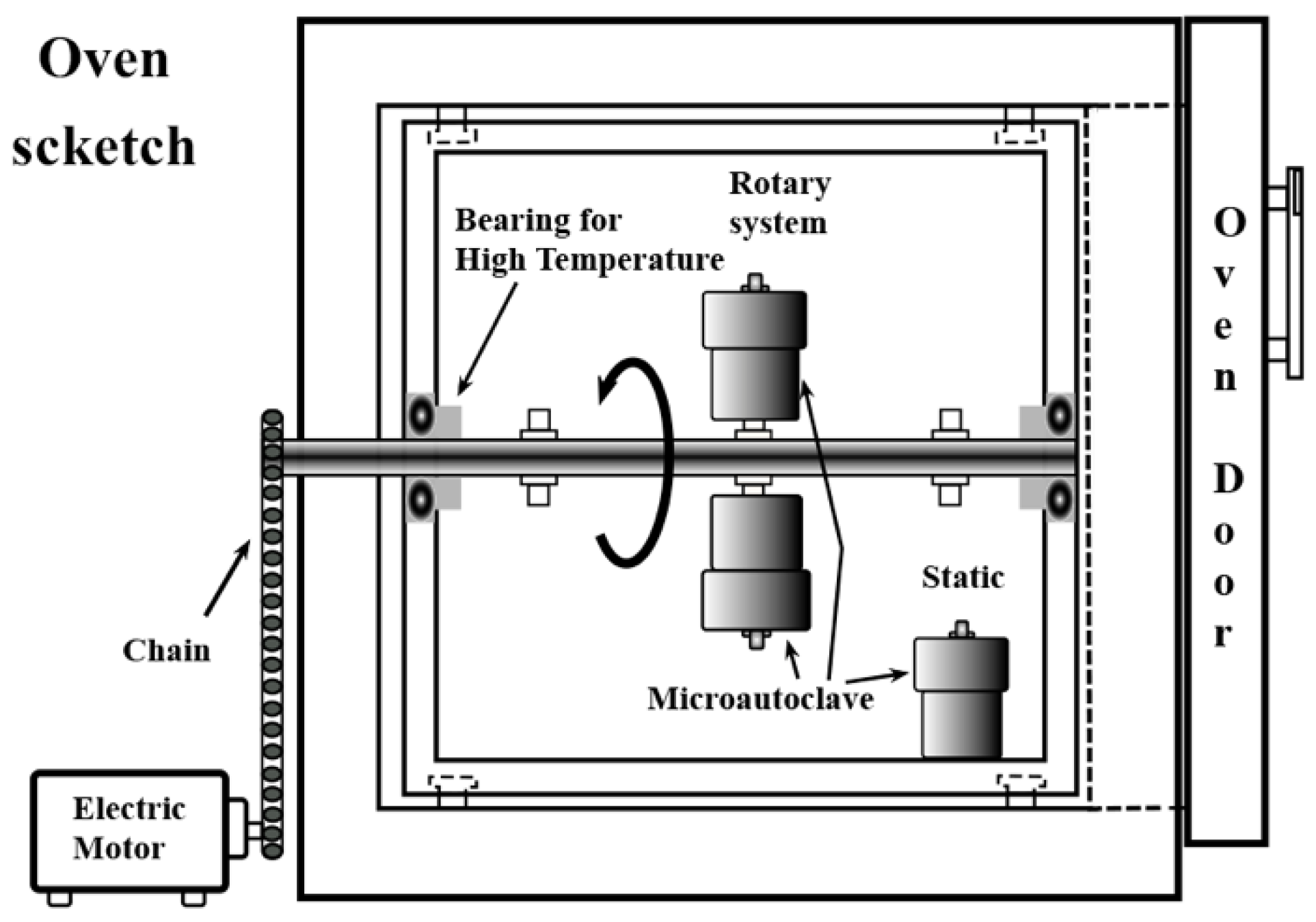
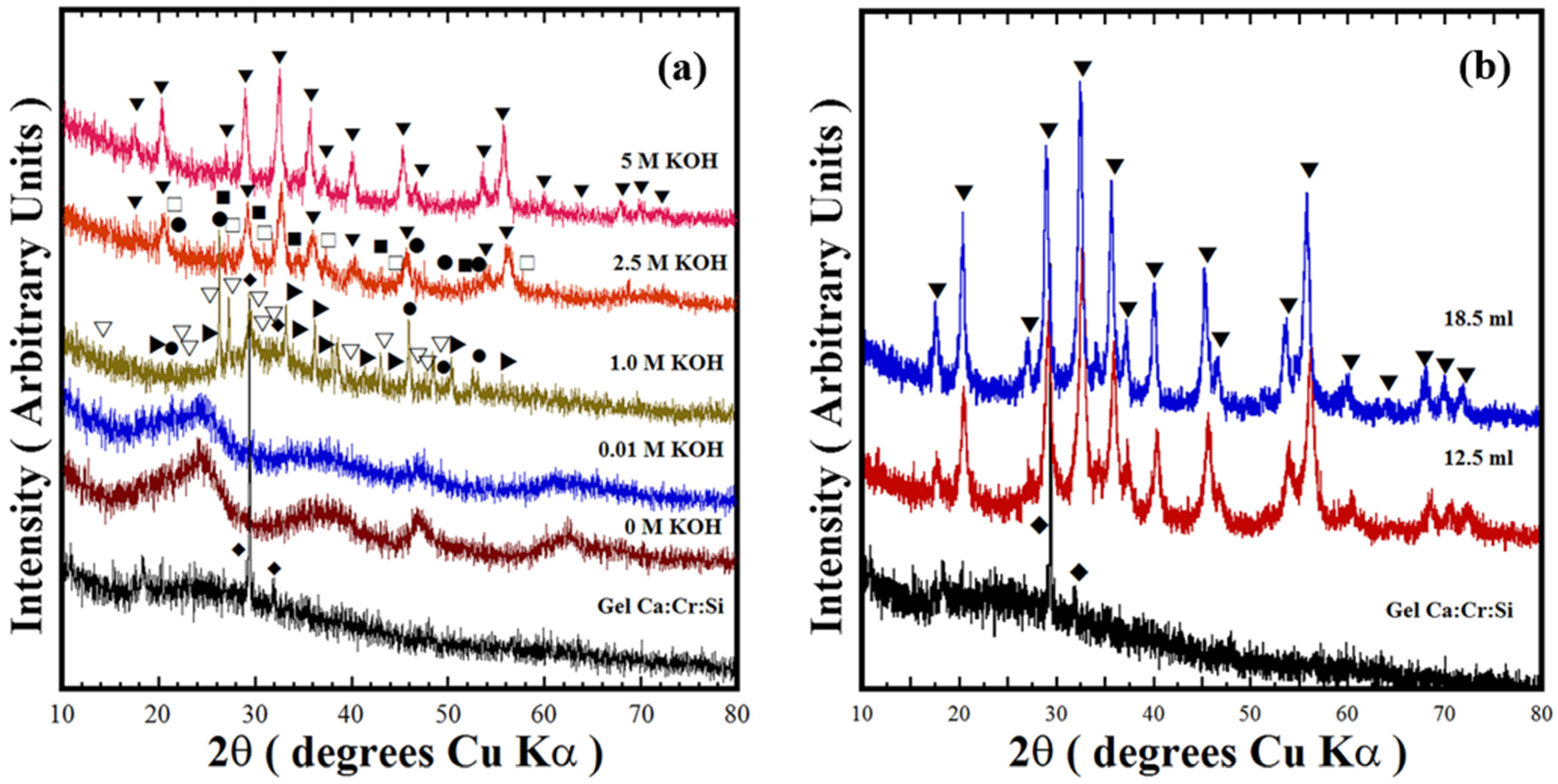
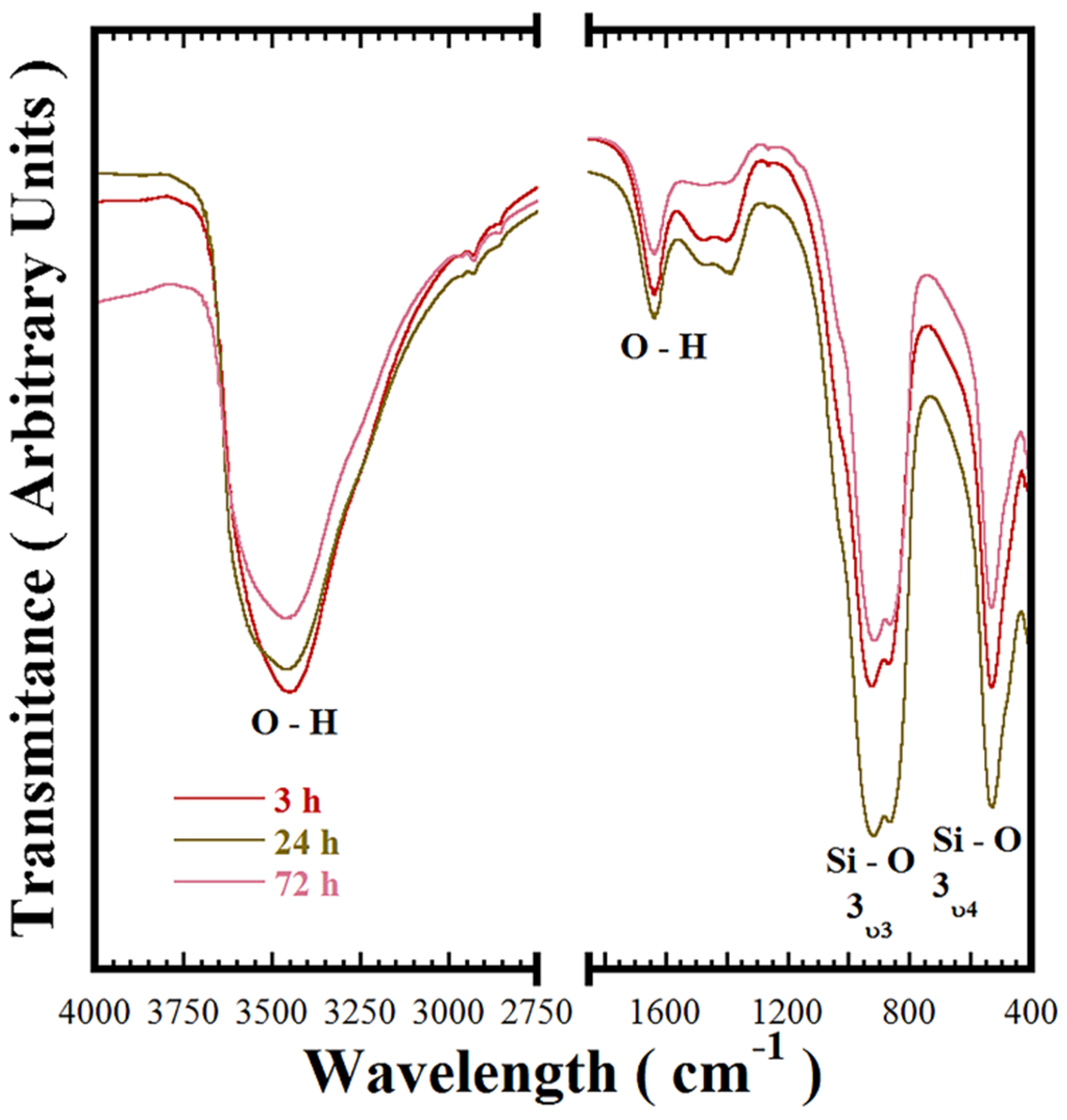
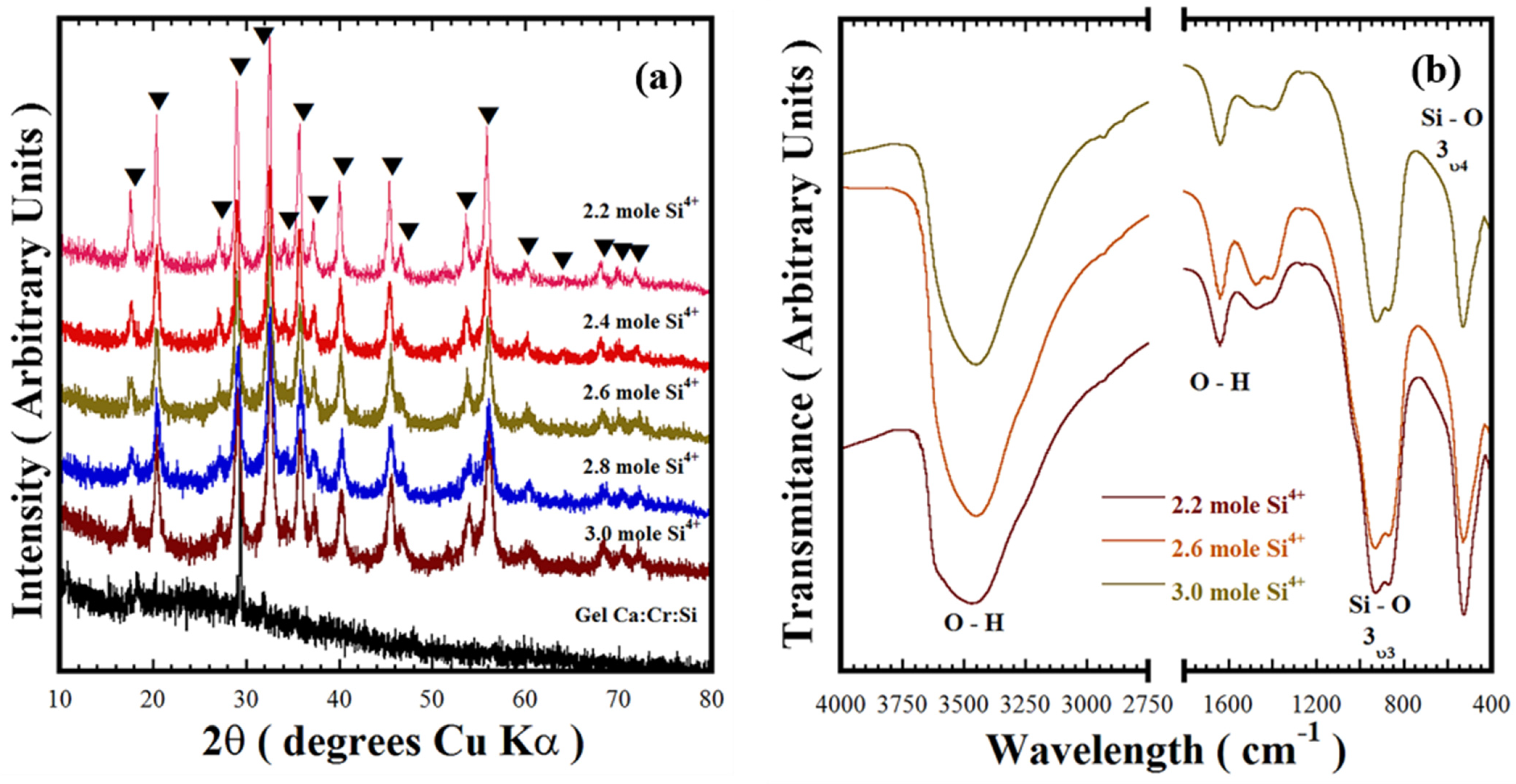


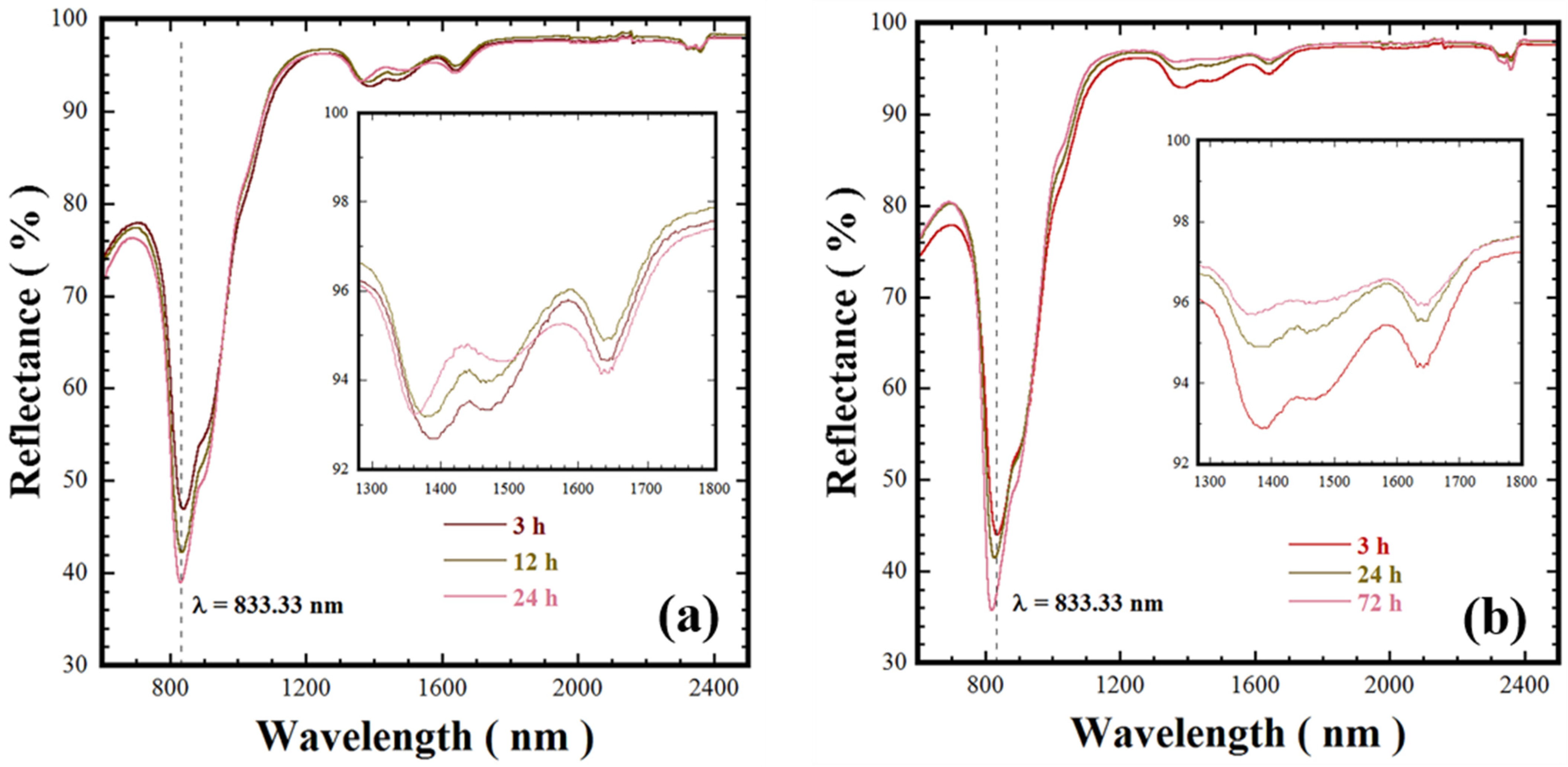
| Sample ID | KOH Solution [M] | Temperature (°C) | Time (h) | Stirring Speed (rpm) | Si4+ Nominal (mole) | Crystalline Phase | Phase Content (wt %) | Average Agglomerate Size (nm) | Rietveld Refinement Structural Parameters | |||||
|---|---|---|---|---|---|---|---|---|---|---|---|---|---|---|
| Crystallite Size (nm) | “a0” (Å) | Cell Volume (Å3) | Lattice Strain | Rwp | GOF (χ2) | |||||||||
| CCS1 | 5.0 * | 220 | 24 | 50 | 3.0 | Uvarovite | 100.0 | - | 18.91 (0.31) | 12.3377 (63) | 1878.06 (2.9) | 0.49 (0.02) | 7.14 | 2.97 |
| CCS2 | 5.0 ** | 220 | 24 | 50 | 3.0 | Uvarovite | 100.0 | 87.0 ± 17.0 | 22.31 (1.29) | 12.2579 (221) | 1841.82 (9.9) | 1.68 (0.05) | 11.60 | 6.56 |
| CCS4 | 2.5 * | 220 | 24 | 50 | 3.0 | Uvarovite | 65.01 | - | 12.68 (0.46) | 12.2379(18) | 1832.82 (0.8) | 1.05 (0.08) | 6.73 | 2.43 |
| Quartz, SiO2 | 1.66 | |||||||||||||
| Ca2SiO5 | 16.93 | |||||||||||||
| Ca2SiO4 | 16.39 | |||||||||||||
| CCS3 | 1.0 * | 220 | 24 | 50 | 3.0 | Quartz, SiO2 | 10.15 | - | - | - | - | - | 11.48 | 6.55 |
| CaCr2O4 | 41.84 | |||||||||||||
| Ca2SiO4 | 48.01 | |||||||||||||
| CCS7 | 0.01 * | 220 | 24 | 50 | 3.0 | Amorphous | 100.0 | - | - | - | - | - | - | - |
| CCS8 | 0.0 * | 220 | 24 | 50 | 3.0 | Amorphous | 100.0 | - | - | - | - | - | - | - |
| CCS9 | 5.0 * | 240 | 3 | 50 | 3.0 | Uvarovite | 100.0 | - | 22.65 (0.93) | 12.3332 (148) | 1876.00 (6.8) | 0.76 (0.04) | 13.62 | 7.25 |
| CCS17 | 5.0 ** | 240 | 12 | 50 | 3.0 | Uvarovite | 100.0 | 145.0 ± 22.0 | 27.38 (1.56) | 12.2468 (112) | 1836.86 (5.1) | 1.43 (0.04) | 12.04 | 6.74 |
| CCS19 | 5.0 ** | 240 | 6 | 0 | 3.0 | Uvarovite | 100.0 | 137.0 ± 25.0 | 55.86 (5.05) | 12.2753 (157) | 1849.71 (7.1) | 1.85 (0.04) | 14.48 | 6.83 |
| CCS21 | 5.0 ** | 240 | 24 | 0 | 3.0 | Uvarovite | 100.0 | 156.0 ± 3.0 | 29.33 (2.24) | 12.2575 (152) | 1841.64 (4.8) | 1.42 (0.03) | 15.11 | 6.89 |
| CCS23 | 5.0 ** | 240 | 72 | 0 | 3.0 | Uvarovite | 100.0 | 99.0 ± 20.0 | 23.87 (0.41) | 12.2429 (39) | 1835.08 (1.8) | 0.78 (0.01) | 6.96 | 2.82 |
| CCS15 | 5.0 ** | 220 | 6 | 0 | 3.0 | Uvarovite | 100.0 | 173.0 ± 29.0 | 32.14 (4.93) | 12.3016 (347) | 1861.63 (15.7) | 1.96 (0.10) | 10.72 | 6.16 |
| CCS14 | 5.0 ** | 220 | 12 | 0 | 3.0 | Uvarovite | 100.0 | 112.0 ± 15.0 | 19.96 (0.48) | 12.2750 (87) | 1849.55 (4.0) | 1.05 (0.03) | 6.90 | 2.84 |
| CCS13 | 5.0 ** | 220 | 24 | 0 | 3.0 | Uvarovite | 100.0 | 148.0 ± 3.0 | 13.07 (0.25) | 12.2475 (106) | 1837.18 (4.8) | 0.68 (0.05) | 6.15 | 2.74 |
| CCS31 | 5.0 ** | 220 | 12 | 0 | 2.6 | Uvarovite | 100.0 | 114.0 ± 17.0 | 14.45 (0.29) | 12.2936 (67) | 1858.00 (3.0) | 0.49 (0.05) | 6.20 | 2.79 |
| CCS32 | 5.0 ** | 220 | 12 | 0 | 2.4 | Uvarovite | 100.0 | 104.0 ± 23.0 | 23.57 (1.13) | 12.3277 (133) | 1873.47 (6.0) | 0.48 (0.04) | 16.61 | 7.19 |
| CCS33 | 5.0 ** | 220 | 12 | 0 | 2.2 | Uvarovite | 100.0 | 90.0 ± 28.0 | 28.26 (0.80) | 12.3372 (75) | 1877.82 (0.3) | 0.73 (0.01) | 6.51 | 2.88 |
| CCS28 | 5.0 ** | 200 | 6 | 0 | 3.0 | Uvarovite | 100.0 | - | 12.79 (1.83) | 12.3340 (984) | 1876.35 (45.0) | 2.0 (0.39) | 12.52 | 5.88 |
| CCS26 | 5.0 ** | 200 | 24 | 0 | 3.0 | Uvarovite | 100.0 | - | 12.66 (0.28) | 12.2767 (136) | 1850.33 (6.1) | 0.88 (0.04) | 6.63 | 2.76 |
| CCS24 | 5.0 ** | 200 | 72 | 0 | 3.0 | Uvarovite | 100.0 | 66.0 ± 23.0 | 19.06 (0.44) | 12.2708 (98) | 1847.66 (4.4) | 1.03 (0.03) | 6.71 | 2.81 |
| Sample ID | KOH Solution [M] | Temperature (°C) | Time (h) | Stirring Speed (RPM) | Si4+ Nominal (mole) | Average Agglomerate Size (nm) | CIELab Coordinates | RGB Colour Coordinates | Chroma Cab* | Colour Hue | ||||
|---|---|---|---|---|---|---|---|---|---|---|---|---|---|---|
| L* | a* | b* | R | G | B | |||||||||
| Gel CCS | - | - | - | - | - | - | 64.31 | −16.74 | 1.16 | 123 | 165 | 153 | 16.78 | |
| CCS8 | 0.0 | 220 | 24 | 50 | 3.0 | - | 32.80 | −43.49 | 14.88 | 0 | 93 | 51 | 45.97 | |
| CCS7 | 0.01 | 220 | 24 | 50 | 3.0 | - | 41.75 | −35.60 | 5.75 | 0 | 113 | 88 | 36.07 | |
| CCS1 | 5.0 | 220 | 24 | 50 | 3.0 | - | 58.97 | −17.78 | −3.63 | 102 | 151 | 148 | 18.16 | |
| CCS2 | 5.0 | 220 | 24 | 50 | 3.0 | 87.0 ± 17.0 | 58.03 | −22.13 | −3.66 | 88 | 151 | 145 | 22.44 | |
| CCS4 | 2.5 | 220 | 24 | 50 | 3.0 | - | 67.04 | −16.89 | 5.41 | 133 | 172 | 153 | 17.75 | |
| CCS13 | 5.0 | 220 | 24 | 0 | 3.0 | 148.0 ± 3.0 | 59.98 | −22.21 | −4.24 | 93 | 156 | 151 | 22.62 | |
| CCS21 | 5.0 | 240 | 24 | 0 | 3.0 | 156.0 ± 3.0 | 64.16 | −18.75 | −3.06 | 114 | 165 | 160 | 19.00 | |
| CCS23 | 5.0 | 240 | 72 | 0 | 3.0 | 99.0 ± 20.0 | 62.99 | −18.68 | −3.10 | 111 | 162 | 157 | 18.94 | |
| CCS24 | 5.0 | 200 | 72 | 0 | 3.0 | 66.0 ± 23.0 | 60.57 | −20.04 | −3.78 | 100 | 157 | 152 | 20.40 | |
| CCS14 | 5.0 | 220 | 12 | 0 | 3.0 | 112.0 ± 15.0 | 66.52 | −17.22 | −1.78 | 125 | 171 | 164 | 17.31 | |
| CCS31 | 5.0 | 220 | 12 | 0 | 2.6 | 114.0 ± 17.0 | 60.79 | −19.48 | −4.13 | 102 | 157 | 153 | 19.92 | |
| CCS33 | 5.0 | 220 | 12 | 0 | 2.2 | 90.0 ± 28.0 | 72.44 | −12.95 | −0.79 | 151 | 185 | 179 | 12.98 | |
Publisher’s Note: MDPI stays neutral with regard to jurisdictional claims in published maps and institutional affiliations. |
© 2021 by the authors. Licensee MDPI, Basel, Switzerland. This article is an open access article distributed under the terms and conditions of the Creative Commons Attribution (CC BY) license (http://creativecommons.org/licenses/by/4.0/).
Share and Cite
Rendón-Angeles, J.C.; Matamoros-Veloza, Z.; Rodríguez-Galicia, J.L.; Seong, G.; Yanagisawa, K.; Tamayo, A.; Rubio, J.; Anaya-Chavira, L.A. One-Pot Hydrothermal Synthesis of Victoria Green (Ca3Cr2Si3O12) Nanoparticles in Alkaline Fluids and Its Colour Hue Characterisation. Nanomaterials 2021, 11, 521. https://doi.org/10.3390/nano11020521
Rendón-Angeles JC, Matamoros-Veloza Z, Rodríguez-Galicia JL, Seong G, Yanagisawa K, Tamayo A, Rubio J, Anaya-Chavira LA. One-Pot Hydrothermal Synthesis of Victoria Green (Ca3Cr2Si3O12) Nanoparticles in Alkaline Fluids and Its Colour Hue Characterisation. Nanomaterials. 2021; 11(2):521. https://doi.org/10.3390/nano11020521
Chicago/Turabian StyleRendón-Angeles, Juan Carlos, Zully Matamoros-Veloza, Jose Luis Rodríguez-Galicia, Gimyeong Seong, Kazumichi Yanagisawa, Aitana Tamayo, Juan Rubio, and Lluvia A. Anaya-Chavira. 2021. "One-Pot Hydrothermal Synthesis of Victoria Green (Ca3Cr2Si3O12) Nanoparticles in Alkaline Fluids and Its Colour Hue Characterisation" Nanomaterials 11, no. 2: 521. https://doi.org/10.3390/nano11020521
APA StyleRendón-Angeles, J. C., Matamoros-Veloza, Z., Rodríguez-Galicia, J. L., Seong, G., Yanagisawa, K., Tamayo, A., Rubio, J., & Anaya-Chavira, L. A. (2021). One-Pot Hydrothermal Synthesis of Victoria Green (Ca3Cr2Si3O12) Nanoparticles in Alkaline Fluids and Its Colour Hue Characterisation. Nanomaterials, 11(2), 521. https://doi.org/10.3390/nano11020521









